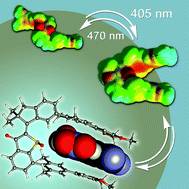Sulfoxide hemithioindigo tweezers – visible light addressable capture and release†
Abstract
Introducing responsive elements into supramolecular recognition systems offers great advantages for the control of intermolecular interactions and represents an important stepping stone towards multi-purpose and reprogrammable synthetic systems. Of particular interest is implementation of light-responsiveness because of the unique ease and precision of this signal. Here we present visible light responsive hemithioindigo-based molecular tweezers that bear a highly polar sulfoxide function as an additional recognition unit inside their binding site. Sulfur oxidation allows to simultaneously enhance all crucial properties of this receptor type i.e. photoswitching capability, thermal stability of individual switching states, binding affinity, and binding modulation upon switching. With a novel titration method the thermodynamic binding parameters were determined using reduced sample amounts. Employing these strongly enhanced molecular tweezers allowed to demonstrate photocontrol of intermolecular charge transfer in a reversible manner.



 Please wait while we load your content...
Please wait while we load your content...